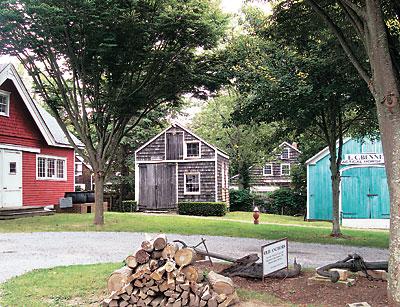Forging a New Blacksmith Shop

The story of the building known as the E. and C. Bennett Blacksmith Shop at the Southampton Historical Museum began and ended with a tree.
The shop building, complete with a functioning forge, was originally built from local oaks in about 1790, moved to the museum from Hampton Road in the 1970s, and was restored in the 1990s. There it stood until Aug. 28
when winds from Tropical Storm Irene blew through Southampton Village and toppled a large tree, which came crashing down on the shop. Then, its story began anew. Robert Strada, who along with Dick Baxter led the team that brought the blacksmith shop back to life, said recently that the tree could not have hit the building in a more damaging place, striking it right at the roof’s ridge. “Any slight difference in the angle and the building would have stood, but the sides fell in like a pancake.”
A month later, Mr. Baxter and Mr. Strada were onsite, leading a cleanup and reclamation effort. The aim was not just to rebuild the structure as it originally looked, but to use as much of the original materials as possible.
Many of the timbers and boards were destroyed by the storm. Others were weakened through rot or insect damage over the years and could not be used again safely. Still, the team was able to isolate, identify, and tag many pieces, both interior and exterior, in order to place them in the refurbished structure where they were originally used.
Mr. Strada said the effort at reconstruction adhered strictly to the Secretary of the Interior’s standards and guidelines for historic preservation, established in 1983, which provide technical advice “about archeological and historic preservation activities and methods,” according to the National Parks Service, which administers them.
The guidelines allow for some interpretation in reconstruction and renovation as long as it is in keeping with the original and integrates as much as is worth saving from the original structure.
In the case of the beyond-repair curved door frame, the original structure used a system of cuts in the wood that allowed it to be bent and shaped. In replacing it, Mr. Strada said steaming the wood in order to shape it was a more modern and preferable technique that made the frame stronger while still executing a faithful reproduction.
The doors, which survived, retain the original hardware and hinges “probably made by the person who built the shop,” he said. While the blue-green paint was most likely a later addition, they decided to keep it on the doors as a remnant of the building’s most recent incarnation. The facade, however, constructed out of new wood, has not been painted to match as it was previously. The shop’s one window (to keep it relatively dark so the blacksmith could gauge the temperature of the metal through its color) had to be reconstructed on the building’s south side.
The new structure has incorporated some of the original siding and posts, and much of the original floor joists and planks. The posts and beams were blended into the structure with new oak using mortise and tenon, or tongue and groove, joints, strengthened by wooden pegs, also known as trunnels, just as the original had been built. The siding was attached using spline joints, which are consistent with late 18th-century building practices. Except for the hardware in the shop’s doors, which had been there previously, no nails were used in the new building. Mr. Strada said the resulting structure is closer to an art form, like sculpture, than a building, although just as sound.
The forge was first reconstructed in the 1970s with brick from that time. The base still stood in the wreckage but the chimney had to be reconstructed. “We found older bricks and used them instead,” Mr. Strada said. Once the shop is officially open, John Battle, a blacksmith who also operates a shop on the Bridgehampton Historical Society property, will return to do demonstrations as he had previously.
The early history of the shop is sketchy. The museum named it after another shop from the 19th century, the E. and C. Bennett Practical Horse Shoers. Mr. Strada said he had a photograph in his files from about 1911 of Robert S. Hildreth standing in front of the building with a young boy, possibly Edward Hildreth. He added that the shop was purchased by James Burnett from Hildreth in 1958 and used as a blacksmith shop until 1973.
Tom Edmonds, the director of the museum, said in its final state before coming to the museum it was used as a stable and then to house taxis. It was moved to the Meeting House Lane site in 1976. Mr. Strada said the building came with the original equipment from Burnett’s shop when he went out of business.
Mr. Strada described preservation efforts like these as important in an area with a rich historical heritage. He is in the process of registering a new nonprofit organization “to promote, protect, and preserve the historic built environment of the North and South Forks” and will announce the effort formally once it is approved.
The museum will offer a “hard hat tour” of the shop next Thursday at 6 p.m. after its annual meeting at 5. The public has been invited for the tour.
